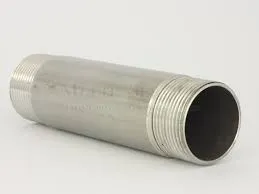-
Cangzhou Yulong Steel Co., Ltd.
-
Phone:
+86 13303177267 -
Email:
admin@ylsteelfittings.com
- English
- Arabic
- Italian
- Spanish
- Portuguese
- German
- kazakh
- Persian
- Greek
- French
- Russian
- Polish
- Thai
- Indonesian
- Vietnamese
- Zulu
- Korean
- Uzbek
- Hindi
- Serbian
- Malay
- Ukrainian
- Gujarati
- Haitian Creole
- hausa
- hawaiian
- Hebrew
- Miao
- Hungarian
- Icelandic
- igbo
- irish
- Japanese
- Javanese
- Kannada
- Khmer
- Rwandese
- Afrikaans
- Albanian
- Amharic
- Armenian
- Azerbaijani
- Basque
- Belarusian
- Bengali
- Bosnian
- Bulgarian
- Catalan
- Cebuano
- China
- China (Taiwan)
- Corsican
- Croatian
- Czech
- Danish
- Esperanto
- Estonian
- Finnish
- Frisian
- Galician
- Georgian
- Kurdish
- Kyrgyz
- Lao
- Latin
- Latvian
- Lithuanian
- Luxembourgish
- Macedonian
- Malgashi
- Malayalam
- Maltese
- Maori
- Marathi
- Mongolian
- Myanmar
- Nepali
- Norwegian
- Norwegian
- Occitan
- Pashto
- Dutch
- Punjabi
- Romanian
- Samoan
- Scottish Gaelic
- Sesotho
- Shona
- Sindhi
- Sinhala
- Slovak
- Slovenian
- Somali
- Sundanese
- Swahili
- Swedish
- Tagalog
- Tajik
- Tamil
- Tatar
- Telugu
- Turkish
- Turkmen
- Urdu
- Uighur
- Welsh
- Bantu
- Yiddish
- Yoruba

Aug . 25, 2024 08:48 Back to list
Understanding the Specifications and Applications of 1 Pipe Flanges in Industry
Understanding 1 Pipe Flange Essential Components in Piping Systems
In the world of engineering and industrial applications, the components that connect pipes are of paramount importance. Among these, the pipe flange has gained significant attention due to its critical role in providing secure and reliable connections within piping systems. In this article, we will explore the concept of the 1 pipe flange, delving into its specifications, applications, and benefits.
Understanding 1 Pipe Flange Essential Components in Piping Systems
When examining the specifications associated with the 1 pipe flange, it is essential to consider the dimensions, pressure ratings, and material standards that define its usage. The size of the flange is crucial, as it must match the diameter of the pipe it connects. Common standards such as ANSI (American National Standards Institute) and ASME (American Society of Mechanical Engineers) govern the sizing and pressure ratings of flanges, ensuring they can withstand the internal pressures of fluids and gases flowing through the pipes.
1 pipe flange

One noteworthy aspect of the 1 pipe flange is its utilization in systems designed for transporting fluids, chemicals, and gases in various industries. These could include oil and gas, petrochemical, water treatment, and HVAC (Heating, Ventilation, and Air Conditioning) systems, among others. The ability to create a tight seal is essential in these applications to prevent leaks, which can lead to safety hazards, environmental concerns, and costly disruptions.
In addition to their primary function of connecting pipes, 1 pipe flanges also facilitate maintenance and repairs. By using flanged connections, technicians can easily disassemble sections of the piping system for inspection, cleaning, or replacement without having to cut and weld the pipes. This modularity is especially advantageous in complex systems where access might be limited, saving time and reducing costs.
Another significant benefit of the 1 pipe flange is its compatibility with various types of gaskets and sealing materials. These gaskets play a crucial role in forming a tight seal between the flange faces, preventing leaks. The choice of gasket material can depend on several factors, including the type of fluid being transported, temperature, pressure, and even regulatory requirements.
In conclusion, the 1 pipe flange is an essential component in today’s piping systems, providing structural integrity, ease of maintenance, and leak-proof connections. By understanding the specifications and applications of these flanges, engineers and technicians can ensure the safety and efficiency of fluid transport operations across various industries. As we continue to advance in technology and engineering practices, the importance of reliable connections through components like the 1 pipe flange will undoubtedly remain a cornerstone of industrial efficiency and safety.
Latest news
-
ANSI 150P SS304 SO FLANGE
NewsFeb.14,2025
-
ASTM A333GR6 STEEL PIPE
NewsJan.20,2025
-
ANSI B16.5 WELDING NECK FLANGE
NewsJan.15,2026
-
ANSI B16.5 SLIP-ON FLANGE
NewsApr.19,2024
-
SABS 1123 FLANGE
NewsJan.15,2025
-
DIN86044 PLATE FLANGE
NewsApr.19,2024
-
DIN2527 BLIND FLANGE
NewsApr.12,2024
-
JIS B2311 Butt-Welding Fittings LR/SR 45°/90° /180°Seamless/Weld
NewsApr.23,2024











